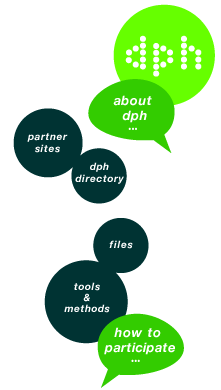
|
dph is member of the Coredem |
dialogues, proposals, stories for global citizenship
What is a resource site?
The desire to create resource sites is based on the extension of the philosophy of the exchange of experiences and the dph project: producing knowledge that is useful to action.
Internet terminology varies. There is no single commonly accepted definition of what constitutes a “resource site”. So we are providing our definition.
“Resource site” is the abbreviation of “Documentary resource site”. The use of the term “resource” is based on the English, where “resource centre” means a “documentary centre”.
The use of the word “resource” in the context of documentation does not seem to us to be just another Anglicism. It appears to be sufficiently relevant to be able to draw the parallel with the natural resource (of a country) human resources (of an organisation) and documentary resources (of a network, a project). Documentary resources are a mass of information that is the body of a network or a project. Behind the idea of resources, there is the idea of a mine waiting to be exploited.
In other words, documentary resources are half way between archives (which are reserved for an initiated public interested mainly in history) and a documentary centre (which provides better organised data).
A resource site meets three criteria:
 Making a large amount of information available
Making a large amount of information available
 Structuring this information
Structuring this information
 An editorial content that throws light on the contents and organisation of the site and that takes an editorial position
An editorial content that throws light on the contents and organisation of the site and that takes an editorial position
Making a large amount of information available
When you only have six documents, a simple inventory list is enough; in this case it would be presumptuous to speak about a “resource site”.
The first characteristic of a resource site is quantitative: it should provide an important quantity of information for the person interested in the subject of the site.
A site can of course have other objectives than that of offering documentary resources. A resource site frequently designates the “resource” section of a wider site offering other types of information (news, discussion forums etc.).
A large mass of information results in constraints, particularly that of organising and facilitating access. This is the second characteristic of a resource site: the information needs to be structured.
Structuring of information
A resource site should provide clear added value as compared with using the Google search engine on Internet. This added value is provided by the organisation of the information, by work that is carried out upstream by the pre-organisation and classification of knowledge. To do this, the preferred tool of resource sites is the indexing of information via key words and concepts.
This will do several things: improve the relevance of the research of free text, providing the user with an overview of the thematic field covered by the site, creating a gateway to the site contents and allowing an explanation of the terminology used. The choice of key concepts is neither haphazard nor neutral, it is the third characteristic of a resource site: the editorial content.
Editorial content
The existence of an editorial content is without doubt the factor of a resource site that distinguishes it from a classical documentary centre. A resource site does not aim to be exhaustive and takes a specific angle.
This editorial content can be identified at two levels:
 At content level:
At content level:
When a resource site proposes files of diverse origin on line, there has been work carried out upfront by the site managers in terms of re-reading and editing. Some content may also have been specifically written for the resource site.
 In terms of the structuring of information:
In terms of the structuring of information:
As we seen in the previous point, the key concepts chosen to index the files, the major themes of the site are not neutral
The editorial content is the reflection of choices that have been made. A resource site is never an end unto itself. It always forms part of a wider project. As stated in the introduction, the term “documentary resources” is relevant, as it includes the idea of “documents that serve…”



